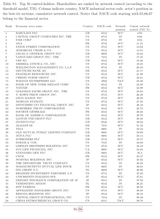Search Results
7/8/2025, 1:33:40 PM
let me post this for posterity:
https://arxiv.org/pdf/1107.5728.pdf
The network of global corporate control
Stefania Vitali, James B. Glattfelder and Stefano Battiston
>The structure of the control network of transnational corporations affects global market competition and financial stability. So far, only small national samples were studied and there wasno appropriate methodology to assess control globally. We present the first investigation of the architecture of the international ownership network, along with the computation of the control held by each global player. We find that transnational corporations form a giant bow-tie structure and that a large portion of control flows to a small tightly-knit core of financial institutions.This core can be seen as an economic “super-entity” that raises new important issues both for researchers and policy makers.
> a large portion of control flows to a small tightly-knit core of financial institutions.This core can be seen as an economic “super-entity”
> a large portion of control flows to a small tightly-knit core of financial institutions.This core can be seen as an economic “super-entity”
Pic related
They all sit on each other's boards, own stock in each other's companies. Barclays is the most powerful. The paper is mathematical, out of the Swiss FIT.
Note China is only on this list ONCE and it is LAST.
This list has only been further cemented b/c of NYFed QE since 2008.
https://arxiv.org/pdf/1107.5728.pdf
The network of global corporate control
Stefania Vitali, James B. Glattfelder and Stefano Battiston
>The structure of the control network of transnational corporations affects global market competition and financial stability. So far, only small national samples were studied and there wasno appropriate methodology to assess control globally. We present the first investigation of the architecture of the international ownership network, along with the computation of the control held by each global player. We find that transnational corporations form a giant bow-tie structure and that a large portion of control flows to a small tightly-knit core of financial institutions.This core can be seen as an economic “super-entity” that raises new important issues both for researchers and policy makers.
> a large portion of control flows to a small tightly-knit core of financial institutions.This core can be seen as an economic “super-entity”
> a large portion of control flows to a small tightly-knit core of financial institutions.This core can be seen as an economic “super-entity”
Pic related
They all sit on each other's boards, own stock in each other's companies. Barclays is the most powerful. The paper is mathematical, out of the Swiss FIT.
Note China is only on this list ONCE and it is LAST.
This list has only been further cemented b/c of NYFed QE since 2008.
Page 1
